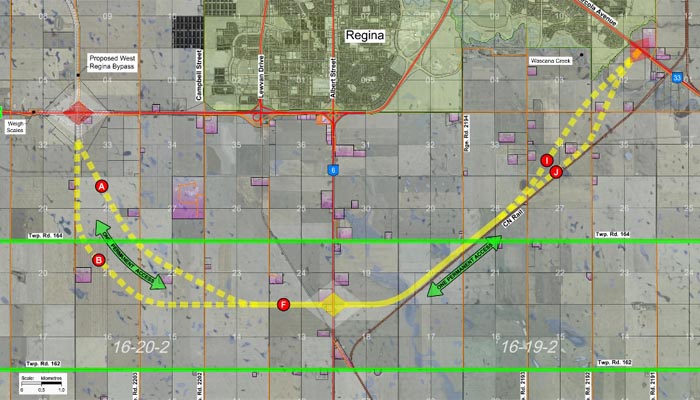Since the year 2000, the City of Regina has experienced a boom in population and infrastructure that has created tremendous benefits and opportunities (and some headaches) in the area.
In many parts of the city, what was once farmland now contains new subdivisions with thousands of new homes. Connecting these new areas to the rest of the city has meant building and upgrading new roads and streets. It has also meant needing to bring in many more supplies and amenities for people to enjoy and on which to live.
[related_content slugs=”reginas-debt-dilemma,regina-braces-for-major-flooding,social-media-and-the-regina-police” description=”More from Jason Antonio” position=”right”]
One of the ways these supplies, amenities and food stuffs are brought is by semi-trucks. Over the years, thousands of semi-trucks have made their way into and through Regina, sometimes stopping to deliver their goods, sometimes not stopping at all and making their way to other cities and towns in the area and province.
But the one thing all of these vehicles have had in common is this: they carry long trailers with heavy loads, piloted by drivers who sometimes have been on the road for way too long. All of these and other factors combine to create unsafe conditions for everyday Reginans and a major breakdown in infrastructure.
And for everyone driving in from the east, there is only one access point to reach the Ring Road. This is a highway that rings nearly the entire city and allows for access to various subdivisions and other highways that connect to the city. Every semi-truck that drives in from the east of the city has to drive through a lengthy stretch of eastern Regina, using the main thoroughfare of Victoria Avenue, before finally hooking up to the off-ramp at the Victoria Avenue and Ring Road bypass.
For seven years, people have been clamouring for another type of bypass to be built further away from the city in the east, one that would take heavy loads off Victoria Avenue and enable these drivers to very quickly access the Ring Road and then Highway 1 west or Highway 11 north. Much talk has come from the city and the provincial government, but very little work has been done.
In the meantime, the Trans-Canada Highway leading into Regina from the east has had numerous stoplights planted so that semi-truck drivers would begin to slow down as they entered the city. Leaving and entering Regina from the east has certainly slowed to a crawl. However, there is once again more talk of building a bypass east of Regina.
Unfortunately, the province has said no route has been finalized. Schematics created by the province’s highways department show that the bypass would start at the south end of Pinkie Road in Regina’s west end, go southeast from there, cross Highways 6 and 33, before re-joining the Trans-Canada Highway at Tower Road in the east end of the city.
The bypass would be expected to divert traffic far outside the city by about two kilometres, especially the heavy semi-trucks expected to come from, in increasing numbers, the Global Transportation Hub on Regina’s west end. This Hub is a massive warehouse with a number of businesses that act as a collection point for various things, such as recycling, clothing and food stuffs. Trucks bring things to the Hub and trucks carry things away from the Hub, all destined for various places in the city, province, and outside the province.
Currently being constructed at the intersection of Highway 1 west and Pinkie Road (on which the Hub is located) is a bypass running north-south, which is expected to head up the west side of Regina and connect with Highway 11 in the north end leading to Saskatoon.
Once the route has been finalized, the next step the province has to take is in working with the affected landowners and compensating them for the loss of their land, upon which the new highways and bypasses will be built. And that can be a tricky process, as the government may not be as willing to pony up the required compensation for which the landowners are looking.
One farmer claimed that he was offered compensation for his land, but based on his land’s value when he bought it in the 1970s. Can you imagine what that piece of land would be worth more than 40 years later? It would be way into the millions and millions for sure. Land around this city (and even housing lots, for that matter) is selling at exceptionally high levels. As an example, to even buy a lot for a home in one of the newest subdivisions, Harbour Landing, will set you back roughly $750,000 to $1 million. That’s pretty steep for a city the size of Regina.
Whatever the province decides on a route for this new bypass, it needs to get it done soon and negotiate fairly with the landowners. I personally am sick of having to deal with semi-trucks that drive streets not meant for their heavy loads, leaving those streets in pretty rough shape. And by rough shape I mean roller coaster rides every day. Moreover, I am wary of the safety hazards semis pose on the road. When they want to turn, they always – and I mean always – swing out wide to the left just so they don’t clip the curb or sidewalk on the right-hand side.
While these issues may be the norm for what other larger centres experience, at least those places have highways capable of funneling these big rigs away from major thoroughfares (the Deerfoot Trail in Calgary, anyone?). The City of Regina needs to ensure the safety of its citizens is taken into account, along with the conditions of its roads. Frankly, I’m not keen on having to dig deeper into my pockets to repair roads damaged by some guy from Ontario just passing through.
—
Jason Antonio is the Regina correspondent for Spectator Tribune.
